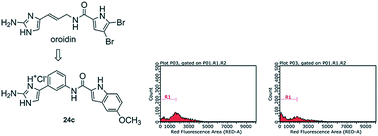Analogues of the marine alkaloids oroidin, clathrodin, and hymenidin induce apoptosis in human HepG2 and THP-1 cancer cells†
Abstract
The marine

* Corresponding authors
a
University of Ljubljana, Faculty of Pharmacy, Aškerčeva 7, 1000 Ljubljana, Slovenia
E-mail:
lucija.peterlin@ffa.uni-lj.si
Fax: +386-1-4258031
Tel: +386-1-4769635
b
Laboratoire d'Innovation Thérapeutique, UMR 7200, Faculté de Pharmacie, Université de Strasbourg, 67401 Illkirch, France
E-mail:
cdmuller@unistra.fr
Fax: +33-368854310
Tel: +33-688285839
c Plateforme eBioCyt, Faculté de Pharmacie & Féderation Translationnelle de Médecine, Université de Strasbourg, 67401 Illkirch, France
The marine

 Please wait while we load your content...
Something went wrong. Try again?
Please wait while we load your content...
Something went wrong. Try again?
T. Tomašič, D. Nabergoj, S. Vrbek, N. Zidar, Ž. Jakopin, A. Žula, Ž. Hodnik, M. Jukič, M. Anderluh, J. Ilaš, M. S. Dolenc, J. Peluso, G. Ubeaud-Séquier, C. D. Muller, L. P. Mašič and D. Kikelj, Med. Chem. Commun., 2015, 6, 105 DOI: 10.1039/C4MD00286E
To request permission to reproduce material from this article, please go to the Copyright Clearance Center request page.
If you are an author contributing to an RSC publication, you do not need to request permission provided correct acknowledgement is given.
If you are the author of this article, you do not need to request permission to reproduce figures and diagrams provided correct acknowledgement is given. If you want to reproduce the whole article in a third-party publication (excluding your thesis/dissertation for which permission is not required) please go to the Copyright Clearance Center request page.
Read more about how to correctly acknowledge RSC content.
 Fetching data from CrossRef.
Fetching data from CrossRef.
This may take some time to load.
Loading related content
